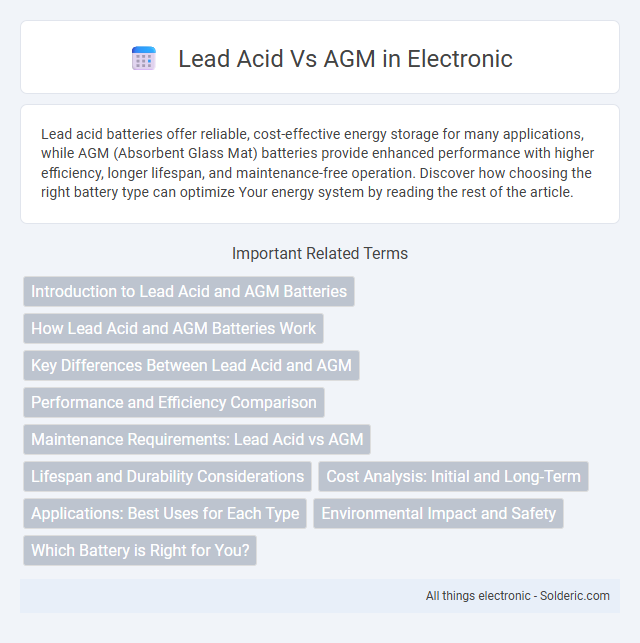Lead acid batteries offer reliable, cost-effective energy storage for many applications, while AGM (Absorbent Glass Mat) batteries provide enhanced performance with higher efficiency, longer lifespan, and maintenance-free operation. Discover how choosing the right battery type can optimize Your energy system by reading the rest of the article.
Comparison Table
| Feature | Lead Acid Battery | AGM Battery |
|---|---|---|
| Technology | Flooded electrolyte, liquid acid | Absorbent Glass Mat, sealed, immobilized electrolyte |
| Maintenance | Requires regular water refilling | Maintenance-free, no water refilling |
| Durability | Less resistant to vibration | Highly vibration resistant |
| Charge Efficiency | Lower charge acceptance | Higher charge acceptance, faster charging |
| Self-Discharge Rate | Higher self-discharge rate | Lower self-discharge rate |
| Cost | Lower initial cost | Higher upfront cost |
| Weight | Heavier, bulkier | Lighter and more compact |
| Application | Automotive, backup power, budget options | High-performance vehicles, motorcycles, solar, UPS |
Introduction to Lead Acid and AGM Batteries
Lead acid batteries, traditionally used in automotive and backup power applications, rely on a liquid electrolyte of sulfuric acid and water. AGM (Absorbent Glass Mat) batteries, a type of lead acid battery, feature a fiberglass mat separator that absorbs the electrolyte, enhancing spill resistance and vibration durability. Choosing the right battery depends on your specific power needs, maintenance preferences, and environmental conditions.
How Lead Acid and AGM Batteries Work
Lead acid batteries generate power through a chemical reaction between lead dioxide and sponge lead plates immersed in sulfuric acid electrolyte, producing electrical energy via the movement of ions. AGM (Absorbent Glass Mat) batteries utilize a similar lead-acid chemistry but differ by using a fiberglass mat separator that absorbs the electrolyte, enhancing efficiency and reducing spillage. Your choice between lead acid and AGM impacts performance, with AGM batteries offering faster recharge times, lower maintenance, and improved durability due to their sealed design.
Key Differences Between Lead Acid and AGM
Lead acid batteries use a liquid electrolyte, while AGM (Absorbent Glass Mat) batteries utilize a fiberglass mat to hold the electrolyte in place, offering enhanced spill resistance and vibration durability. AGM batteries typically have a lower internal resistance, allowing for faster charging and better performance in high-drain applications compared to traditional lead acid batteries. Your choice between the two should consider factors like maintenance needs, lifespan, and application environment, with AGM often preferred for more demanding or compact setups.
Performance and Efficiency Comparison
AGM batteries deliver higher performance and efficiency compared to traditional lead acid batteries due to their sealed design, which reduces electrolyte evaporation and enhances charge acceptance. The low internal resistance of AGM batteries enables faster charging and better energy retention, making them more suitable for high-demand applications. Lead acid batteries, while more affordable, often suffer from lower charge efficiency and reduced lifespan under deep discharge conditions.
Maintenance Requirements: Lead Acid vs AGM
Lead acid batteries require regular maintenance, including checking electrolyte levels and topping up with distilled water, which can be time-consuming and messy. AGM (Absorbent Glass Mat) batteries are maintenance-free, as they are sealed and do not need water refilling or electrolyte monitoring. AGM batteries also resist sulfation better, resulting in longer lifespan and reduced overall maintenance costs compared to traditional lead acid batteries.
Lifespan and Durability Considerations
AGM batteries typically offer a longer lifespan and enhanced durability compared to traditional lead acid batteries due to their sealed design, which reduces water loss and minimizes maintenance needs. Your choice impacts performance in high-vibration environments, with AGM batteries better suited for applications requiring resistance to shocks and extreme conditions. Lead acid batteries generally require more frequent maintenance and have a shorter cycle life, making them less durable over extended use.
Cost Analysis: Initial and Long-Term
Lead acid batteries feature lower initial costs, often making them a more budget-friendly option for applications with limited upfront capital. AGM (Absorbent Glass Mat) batteries, while more expensive initially due to advanced technology and better durability, offer longer lifespan and reduced maintenance expenses that result in lower long-term costs. Evaluating total cost of ownership reveals AGM batteries can provide better value over time despite higher starting prices, especially in high-cycle or deep discharge scenarios.
Applications: Best Uses for Each Type
Lead acid batteries excel in applications requiring high surge currents and cost-effective energy storage, such as in automotive starters, backup power systems, and industrial equipment. AGM batteries are ideal for demanding environments where vibration resistance, maintenance-free operation, and deep cycling capabilities are critical, making them suitable for motorcycles, marine vessels, RVs, and renewable energy storage. You should choose AGM for advanced performance and durability in harsh conditions, whereas standard lead acid is best for conventional, budget-friendly power needs.
Environmental Impact and Safety
Lead acid batteries contain sulfuric acid and lead, which pose significant environmental hazards due to potential acid leaks and heavy metal contamination during disposal. AGM (Absorbent Glass Mat) batteries use a sealed design that minimizes acid spillage, reducing environmental risks and enhancing safety by preventing leaks and corrosion. AGM batteries also exhibit better resistance to vibration and overcharging, lowering the likelihood of accidents compared to traditional flooded lead acid batteries.
Which Battery is Right for You?
Choosing between lead acid and AGM batteries depends on your specific needs and usage patterns. Lead acid batteries are cost-effective and suitable for applications with steady power demands and long charge cycles, while AGM batteries offer superior performance with faster charging, longer lifespan, and better resistance to vibration and temperature extremes. For vehicles, solar systems, or marine use requiring durability and maintenance-free operation, AGM batteries are often the optimal choice.
Lead acid vs AGM Infographic

 solderic.com
solderic.com